James Gordon Bennett Jr.
James Gordon Bennett Jr. (May 10, 1841 – May 14, 1918) was publisher of the New York Herald, founded by his father, James Gordon Bennett Sr. (1795–1872), who emigrated from Scotland. He was generally known as Gordon Bennett to distinguish him from his father. Among his many sports-related accomplishments he organized both the first polo match and the first tennis match in the United States, and he personally won the first trans-oceanic yacht race. He sponsored explorers including Henry Morton Stanley's trip to Africa to find David Livingstone, and the ill-fated USS Jeannette attempt on the North Pole.
James Gordon Bennett Jr. | |
|---|---|
 | |
| Born | May 10, 1841 |
| Died | May 14, 1918 (aged 77) Beaulieu-sur-Mer, Alpes-Maritimes, France |
| Occupation | Publisher |
| Spouse(s) | Baroness de Reuter
( m. 1914; |
| Parent(s) | James Gordon Bennett Sr. Henrietta Agnes Crean |
| Relatives | Isaac Bell Jr. (brother-in-law) |
Early life
Bennett was born on May 10, 1841, in New York City to James Gordon Bennett Sr. (1795–1872), the founder, editor and publisher of the New York Herald. He was the only son in the family. He grew up mostly in France, and attended the École Polytechnique.[1][2]
Career
In 1861, he moved to the United States, and enlisted in the Union Navy. In 1867, under his father's tutelage, he founded The Evening Telegram, an entertainment and gossip paper[1] that later became the New York World-Telegram. On January 1, 1867, the elder Bennett turned control of the Herald over to him.[1] Bennett raised the paper's profile on the world stage when he provided the financial backing for the 1869 expedition by Henry Morton Stanley into Africa to find David Livingstone in exchange for the Herald having the exclusive account of Stanley's progress.
In 1872, he commissioned a Manhattan building design from Arthur D. Gilman, who popularized Second Empire and cast-iron facades. The building still exists, on Nassau Street. Though he sold it in 1889 and it was greatly expanded over the following five years, it continues to be known as The Bennett Building.[1] It was built on a site previously occupied by the Herald's offices and printing plant, and the Herald later moved back into it. In 1890, he commissioned a new Herald building at Sixth and Broadway, completed in 1895.[1]
In 1880, Bennett established international editions of his newspaper in Paris and London; their successor is the New York Times' International Edition, previously known as then International Herald-Tribune.[1] In 1883, he partnered with John W. Mackay to found the Commercial Cable Company. It was a successful business and provided an additional large income to Bennett.[1]
Lifestyle
Bennett, like many of his social class, indulged in the "good life": yachts, opulent private railroad cars, and lavish mansions. He was the youngest Commodore ever of the New York Yacht Club.
Yachts
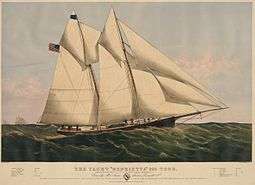
In 1861, Bennett volunteered his newly built schooner yacht, Henrietta, for the U.S. Revenue Marine Service during the Civil War. At the same time, Bennett was commissioned as a third lieutenant in the Revenue Marine Service (equivalent to an ensign in the U.S. Navy) and assigned to the U.S. Marine Revenue schooner Henrietta (the yacht he had loaned to the U.S. Government) beginning in June 1861. She patrolled Long Island until February 1862 when she was sent to Port Royal, South Carolina. On March 3, 1862, Bennett commanded the Henrietta as part of the fleet which captured Fernandina, Florida. Bennett and the Henrietta returned to civilian life in New York in May 1862.[3][4]

In 1866, on a bet, he won the first trans-oceanic yacht race. The race was between three American yachts, the Vesta (owned by Pierre Lorillard IV), the Fleetwing (owned by George and Frank Osgood) and the Henrietta. Each yachtsman put up $30,000 in the winner-take-all wager. They started off of Sandy Hook, New Jersey, on 11 December 1866 amid high westerly winds and raced to The Needles, the furthest westerly point on the Isle of Wight, famous for its lighthouse. Bennett's Henrietta won with a time of 13 days, 21 hours, 55 minutes.[5][6]
He entertained guests aboard his steam-yacht "Namouna". American expatriate artist Julius LeBlanc Stewart painted several works set on the yacht.
Scandal
Bennett often scandalized society with his flamboyant and sometimes erratic behavior. In 1877, he left New York for Europe after an incident that ended his engagement to socialite Caroline May. According to various accounts, he arrived late and drunk to a party at the May family mansion, then urinated into a fireplace (some say grand piano) in full view of his hosts.[2][7][8][9]
Bennett's controversial reputation is thought to have inspired, in Britain, the phrase "Gordon Bennett" as an expression of incredulity.[2][10][11]
Move to Paris
Settling in Paris, he launched the Paris edition of the New York Herald, named The Paris Herald, the forerunner of the International Herald Tribune. He backed George W. De Long's voyage to the North Pole on the USS Jeannette via the Bering Strait.
The ill-fated expedition led to the deaths from starvation of DeLong and 19 of his crew, a tragedy that increased the paper's circulation. He was a co-founder of the Commercial Cable Company, a venture to break the Transatlantic cable monopoly held by Jay Gould.
Return to the US
Bennett returned to the United States and organized the first polo match in the United States at Dickel's Riding Academy at 39th Street and Fifth Avenue in New York. He helped found the Westchester Polo Club in 1876, the first polo club in America. He established the Gordon Bennett Cup for international yachting and the Gordon Bennett Cup for automobile races.[8] In 1906, he funded the Gordon Bennett Cup in ballooning (Coupe Aéronautique Gordon Bennett), which continues to this day. In 1909, Bennett offered a trophy for the fastest speed on a closed circuit for airplanes. The 1909 race in Rheims, France was won by Glenn Curtiss for two circuits of a 10 km rectangular course at an average speed of 46.5 miles per hour (74.8 km/h). From 1896 to 1914, the champion of Paris, USFSA football (soccer), received a trophy offered by Gordon Bennett.
Personal life
He did not marry until he was 73. His wife was Maud Potter, widow of George de Reuter, son of Julius Paul Reuter, founder of Reuters news agency. He died on May 14, 1918, in Beaulieu-sur-Mer, Alpes-Maritimes, France. Bennett is buried at the Cimetière de Passy in Paris.[12]
James Stillman was an intimate friend of James O. Bloss and John William Sterling. After the death of Bennett it was learned by the administrators of his estate that he had appointed Stillman one of the administrators and trustees. Stillman had little or no opportunity to act under the authority of Bennett's will, as he died a few weeks after Bennett's death. Stillman named Sterling one of his executors. Sterling could hardly have begun his duties under Stillman's will when he too died suddenly. The Bennett estate, the Stillman estate and the Sterling estate totaled about $76,000,000. After Sterling's death it was learned that he had appointed his long time intimate companion, Bloss, one of the executors. A few weeks after Sterling's death, Bloss died.[13]
Honors
Asteroid 305 Gordonia is named after him. He also has a street named for him near Chopin Airport in Warsaw, Poland.[14] The Avenue Gordon Bennett in Paris, where the French Open's Stade de Roland Garros is sited is named after his father.[15] Bennett, British Columbia, now a ghost town, as well as nearby Bennett Lake[16] and Bennett Peak are named for him.
Gallery
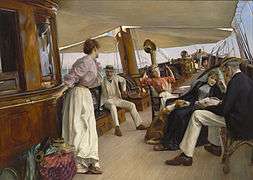 On the Yacht "Namouna", Venice, by Stewart. Bennett is center left, in the white suit. Lillie Langtry is the woman seated, right (1890)
On the Yacht "Namouna", Venice, by Stewart. Bennett is center left, in the white suit. Lillie Langtry is the woman seated, right (1890)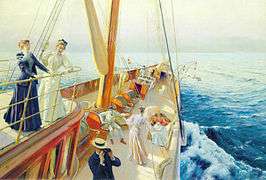 Yachting on the Mediterranean, by Stewart (1896)
Yachting on the Mediterranean, by Stewart (1896).jpg) Bennett as painted by Julian Story (1904)
Bennett as painted by Julian Story (1904)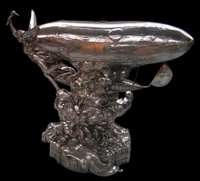 The 1906 Gordon Bennett Cup in Ballooning (1906)
The 1906 Gordon Bennett Cup in Ballooning (1906)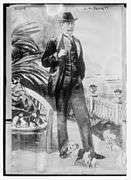 Bennett (c. 1910–1915)
Bennett (c. 1910–1915)
References
- "Landmark Preservation Analysis - Bennett Building - James Gordon Bennett, Jr. and The Daily Herald" (PDF). NYC Landmarks Preservation Commission. p. 2.
- "Gordon Bennett: A puzzling British exclamation" World Wide Words
- "Department of the Navy, Navy Historical Center, "James Gordon Bennett Jr. (1841–1918)"".
- "Schooner Yacht Henrietta (1861)", Department of the Navy, Naval Historical Center,
- Greeley, Horace (1895) The Tribune Almanac and Political Register Tribune Association, New York, 7(1): p. 252, OCLC 2559580
- Thompson, Winfield M. and Lawson, Thomas William (1902) The Lawson History of the America's Cup, Boston, Massachusetts p. 46, OCLC 911964
- Homberger, Eric (2002) Mrs. Astor's New York: Money and Social Power in a Gilded Age Yale University Press, New Haven, Connecticut, page 13, ISBN 0-300-10515-0
- "Britain's first international motor race" Who? What? Where? When? Why? on the World Wide Web
- Wallace, David Rains (1999) The Bonehunters' Revenge: Dinosaurs, Greed, and the Greatest Scientific Feud of the Gilded Age Houghton Mifflin, Boston, page 5, ISBN 0-395-85089-4
- Gordon Bennett!, retrieved 8 September 2017
- Gordon Bennett! - the meaning and origin of this phrase, retrieved 8 September 2017
- "Cimetière de Passy", Paris Cemeteries. Retrieved 5 June 2020
- "Three Strange Coincidences - 21 Dec 1918, Sat • Page 2". The Wall Street Journal: 2. 1918. Retrieved 3 January 2018.
- Ulica Jamesa Gordona Bennetta Warszawa - oficjalny portal stolicy Polski
- Invisible Paris: see street sign
- "Bennett Lake | Yukon Territory Alaska Northern British Columbia".
Further reading
- Crockett, Albert Stevens (1926) When James Gordon Bennett was Caliph of Bagdad Funk & Wagnalls, New York, OCLC 1373863
- Seitz, Don Carlos (1928) The James Gordon Bennetts, Father and Son, Proprietors of the New York Herald Bobbs-Merrill, Indianapolis, OCLC 619637; reissued in 1974 by Beekman Publishers
- O'Connor, Richard (1962) The Scandalous Mr. Bennett Doubleday, Garden City, New York, OCLC 332764
- Cane, André (1981) James Gordon Bennett: Hôte Prestigieux et Fantasque de la Côte d'Azur (James Gordon Bennett: Prestigious and Eccentric Host of the Riviera) B. de Gourcez, Saint-Paul-de-Vence, OCLC 9465414, in French
- Hampton Sides (2014). In the Kingdom of Ice: The Grand and Terrible Polar Voyage of the U.S.S. Jeannette. Doubleday.
- Jefferson, Sam (2016) 'Gordon Bennett and the First Yacht Race Across the Atlantic'. Publisher: Bloomsbury Publishing
- Roethof, Guikje (2018) Gordon Bennett! Uitgeverij Aspekt, Soesterberg, OCLC 1026502787, in Dutch.
External links

- Bennett family history
- Newspaper clippings about James Gordon Bennett Jr. in the 20th Century Press Archives of the ZBW